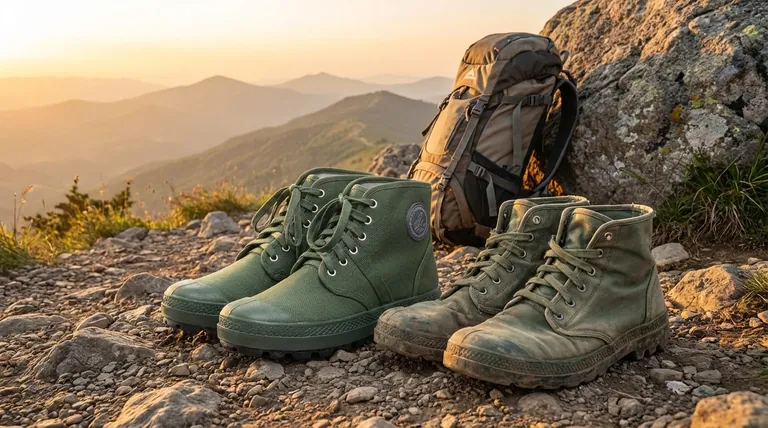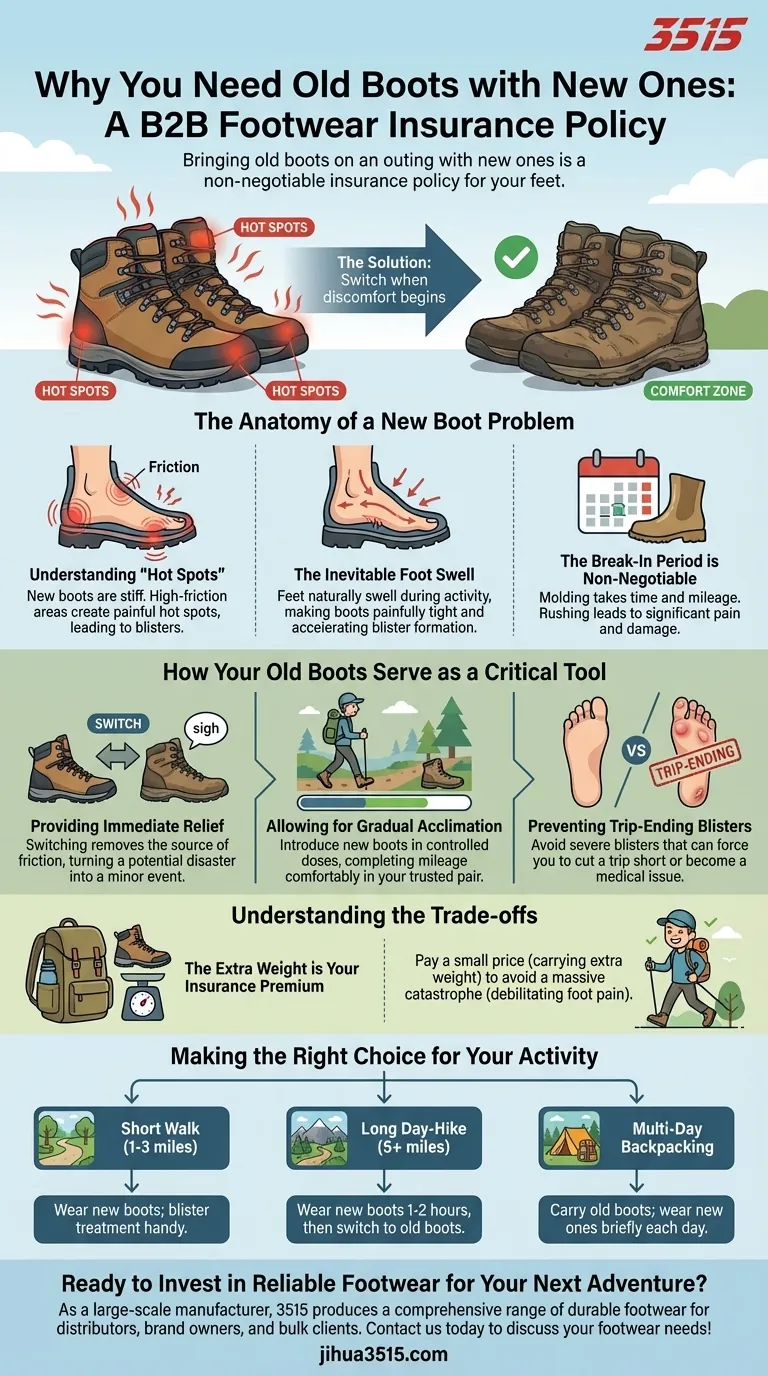Bringing old boots on an outing with new ones is a non-negotiable insurance policy for your feet. This strategy allows you to switch footwear when the inevitable discomfort from stiff, new boots sets in. It prevents painful hot spots from turning into trip-ending blisters and gives your feet a much-needed break as they naturally swell throughout the day.
Your new boots are an investment that must be molded to your feet over time. Bringing your trusted old pair is not a sign of doubt; it's a strategic part of the break-in process that protects you from preventable pain and injury.

The Anatomy of a New Boot Problem
To understand why a backup pair is so critical, you first need to understand what’s happening to your feet inside a new boot. The core issues are friction, pressure, and the body's natural response to activity.
Understanding "Hot Spots"
New boots are constructed from stiff materials like leather or robust synthetics that have not yet conformed to the unique shape of your foot.
This stiffness creates high-friction areas, known as hot spots, where the boot continuously rubs against your skin. Common locations include the heel, ankle bones, and the tops of your toes.
These hot spots are the direct precursor to blisters. Ignoring them is the most common mistake people make.
The Inevitable Foot Swell
During any extended activity like walking or hiking, your feet naturally swell due to increased blood flow and gravity.
A boot that felt perfectly snug in the morning can become painfully tight after just a few hours of effort. This pressure magnifies the friction at hot spots, dramatically accelerating the formation of blisters.
The Break-In Period is Non-Negotiable
The purpose of "breaking in" a boot is to gradually soften its materials and force them to mold to your foot's specific contours.
This process requires time and mileage. It simply cannot be rushed into a single long hike without causing significant pain and damage to your feet.
How Your Old Boots Serve as a Critical Tool
Your old, broken-in boots are more than just a backup; they are an active tool in the break-in process. They provide an escape route from the pain cycle, allowing you to manage your new footwear intelligently.
Providing Immediate Relief
The primary function of the old pair is to give your feet a break. The moment you feel a hot spot forming, you should stop and switch your boots.
By switching to your old, perfectly molded pair, you immediately remove the source of friction. This turns a potential disaster into a minor, manageable event.
Allowing for Gradual Acclimation
This strategy enables you to introduce your feet to the new boots in controlled doses. You might wear the new pair for the first hour or two of a hike while your feet are still fresh.
Once you switch, you can still complete your planned mileage in the comfort of your trusted old boots. This allows you to make progress breaking in the new pair without sacrificing your objective for the day.
Preventing Trip-Ending Blisters
A severe blister can make every step agonizing, potentially forcing you to cut a trip short. In remote environments, it can even become a serious medical issue if it gets infected.
Carrying your old boots is the simplest way to guarantee that foot problems won't be the reason your adventure ends early.
Understanding the Trade-offs
While this strategy is highly effective, it's essential to acknowledge the primary drawback: carrying extra gear.
The Extra Weight is Your Insurance Premium
The most obvious downside is the added weight and bulk of a second pair of boots in your pack. This is a classic trade-off.
Think of it as paying a small, known price (carrying extra weight) to avoid a massive, potential catastrophe (debilitating foot pain that ruins your trip).
When This Strategy is Most Critical
This approach is non-negotiable for multi-day treks, backcountry trips, or any long day-hike where you are far from your starting point.
For short, low-stakes walks around your neighborhood or local park, carrying a second pair is unnecessary. The goal in those situations is simply to clock short bits of mileage to begin the break-in process.
Making the Right Choice for Your Activity
Use this framework to decide when to pack your backup pair.
- If your primary focus is a short, local walk (1-3 miles): Wear your new boots for the entire duration but have blister treatment handy; carrying a second pair is overkill.
- If your primary focus is a long day-hike (5+ miles): Wear the new boots for the first 1-2 hours, then switch into your trusted old pair (which you carry in your pack) for the remainder of the day.
- If your primary focus is a multi-day backpacking trip: Absolutely carry your old boots as a backup. Wear the new ones for the first hour of each day on easy terrain until they feel fully comfortable.
Treating your footwear strategy with this level of care ensures your adventures are defined by the views, not by the pain in your feet.
Summary Table:
| Situation | Strategy |
|---|---|
| Short Walk (1-3 miles) | Wear new boots; blister treatment handy. |
| Long Day-Hike (5+ miles) | Wear new boots 1-2 hours, then switch to old boots. |
| Multi-Day Backpacking | Carry old boots; wear new ones briefly each day. |
Ready to Invest in Reliable Footwear for Your Next Adventure?
As a large-scale manufacturer, 3515 produces a comprehensive range of durable footwear for distributors, brand owners, and bulk clients. Whether you need trusted hiking boots or specialized work footwear, our production capabilities ensure quality and comfort for every step.
Contact us today to discuss your footwear needs and discover how we can support your business or next outdoor endeavor!
Visual Guide

Related Products
- Factory-Direct Wholesale Canvas Boots with High-Traction Rubber Soles
- Wholesale High-Traction Camo Boots - Custom Manufacturer for Brands
- High Performance Fire-Retardant Waterproof Safety Boots
- Premium Wholesale Waterproof Safety Boots High Performance Protection for Industrial Markets
- Factory Direct Wholesale Rain Boots Durable Waterproof & Fully Customizable
People Also Ask
- What should be avoided when storing boots with outsoles? Protect Your Investment from Dry Rot & Decay
- What types of work environments are hiker-style rubber outsoles best for? Ideal for Outdoor & Industrial Safety
- Why is rubber a popular material for shoe soles? Unbeatable Grip, Durability & Value
- Why are rubber soles beneficial in cold-weather boots? Superior Traction & Waterproofing
- What are the advantages of rubber soles in safety boots? Unbeatable Grip & Durability



















